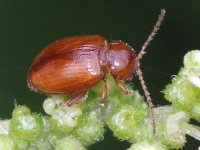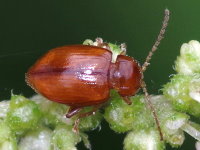Phylum Arthropoda (Arthropods) ➔ Subphylum Hexapoda (Hexapods) ➔ Class Insecta (Insects) ➔ Order Coleoptera (Beetles) ➔ Family Chrysomelidae (Leaf beetles)
Neocrepidodera ferruginea (Scopoli, 1763)
Rotbrauner Weizen-Erdfloh Wheat Flea Beetle
Synonyms and other combinations:
Asiorestia ferruginea (Scopoli, 1763) | Chrysomela ferruginea Scopoli, 1763 |
Further vernacular names:
European Rusted Flea BeetleClassification:
Neocrepidodera ferruginea belongs to the subfamily Galerucinae, tribe Alticini.Distribution:
Azores, Europe, Asia Minor, east to Caucasus and Iran; North America (introduced).Habitat:
Meadows, pastures, ruderal meadows, grain fields.Description:
Length 2.4 - 4.0 mm; rusty brown beetle with slender antennae; wing covers with regular dot stripes; side edge of pronotum narrowly bent up and rounded at the front bristle pore; pronotum broad, transverse impression rather flat; longitudinal stripe rather short, not longer than the distance between posterior corner and stripe.There are several similar species.
Biology:
The reddish brown Wheat Flea Beetle Neocrepidodera ferruginea is a common and widespread univoltine species in Germany.The adult beetles are polyphagous. They are often found on thistles (Cirsium, Carduus) and have been observed on grasses and plants from further families (Asteraceae, Boraginaceae, Fabaceae...).
The beetles hatch at the earliest at the end of May, mostly in June, and can be found until September/October. They are nocturnal and mostly stay on the ground during the day. The eggs are laid at the root neck or on the ground near grasses (Poaceae or Gramineae), the host plants of the larvae. 15 - 20 days later the larvae hatch. The larvae drill into the stem base above the root neck. The entrance hole is kept open. The larvae mine in the stem base or in the root neck of the host grasses. If the plant dies, they move to a new host plant. The hibernation takes place as a mid-instar larva. From May onwards, the larvae leave their host plants and pupate in a burrow. After a pupal period of 2 - 3 weeks the new beetle generation hatches.
Note:
The species is known as a potential pest of winter wheat.References, further reading, links:
- Rheinheimer, Joachim, & Hassler, Michael: Die Blattkäfer Baden-Württembergs, 2018, 928 pages, Kleinsteuber Books (Karlsruhe), ISBN 978-3-9818110-2-5
- Arved Lompe: Die Käfer Europas - Ein Bestimmungswerk im Internet
- Laurent LeSage and Karine Savard: First Record of the European Rusted Flea Beetle, Neocrepidodera ferruginea (Scopoli, 1763), in North America (Coleoptera: Chrysomelidae: Galerucinae: Alticini), Psyche, Volume 2012, Article ID 387564, 11 pages, http://dx.doi.org/10.1155/2012/387564
- Altica sp.
- Bruchus sp.
- Cassida nebulosa
- Cassida sp.
- Cassida stigmatica
- Cassida vibex
- Cassida vibex/bergeali
- Chrysolina lucidicollis
- Chrysolina oricalcia
- Chrysolina sp.
- Chrysolina sturmi
- Chrysolina varians
- Chrysomela tremula
- Coptocephala sp.
- Crepidodera aurea
- Crepidodera fulvicornis
- Cryptocephalus moraei
- Cryptocephalus nitidus
- Cryptocephalus pusillus
- Cryptocephalus sp.
- Donacia cinerea
- Donacia marginata
- Donacia versicolorea
- Galeruca tanaceti
- Galerucella s.l.
- Gonioctena decemnotata
- Gonioctena quinquepunctata
- Gonioctena sp.
- Gonioctena viminalis
- Lema cyanella
- Neocrepidodera sp.
- Oulema melanopus/duftschmidi
- Oulema obscura
- Pachybrachis sp.
- Phratora sp.
- Plagiosterna aenea
- Plateumaris sp.
- Podagrica fuscicornis
- Psylliodes sp.
- Sphaeroderma sp.
- Gonioctena quinquepunctata/intermedia
- Alder Leaf Beetle
- Ant Bag Beetle
- Barley Flea Beetle
- Brassy Willow Leaf Beetle
- Broad Bean Weevil
- Case-bearing Leaf Beetles
- Colorado Potato Beetle
- Dead-nettle Leaf Beetle
- Elm Leaf Beetle
- Four Spotted Leaf Beetle
- Green Dock Beetle
- Green Tortoise Beetle
- Horseradish Flea Beetle
- Imported Willow Leaf Beetle
- Iris Flea Beetle
- Lily Leaf Beetle
- Plantain Leaf Beetle
- Poplar Leaf Beetle
- Skullcap Leaf Beetle
- Spotted Asparagus Beetle
- Spotted Willow Leaf Beetle
- St John's-wort Leaf Beetle
- Thistle Tortoise Beetle
- Turnip Flea Beetle
- Two-tone Reed Beetle
- Viburnum Leaf Beetle
- Western Grape Rootworm
- Wheat Flea Beetle
- Willow Flea Beetle
- Willow Leaf Beetle

